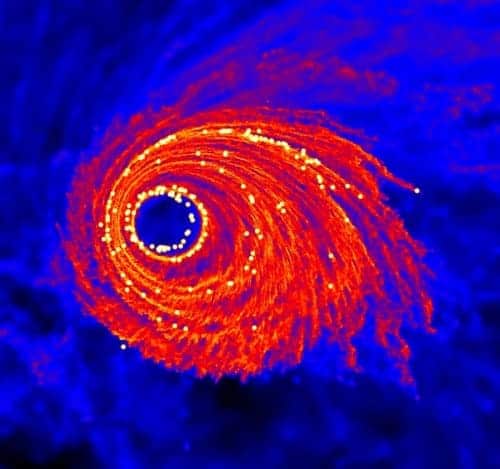
Astrophysicists have long wondered why the centre of our galaxy is populated by massive young stars that, one might think, would be unable to form close to the supermassive black hole that lies at its heart. Now, however, that mystery may have been solved by two researchers in Scotland.
They have carried out computer simulations that suggest that some of the gas swirling into the black hole can form dense clumps that orbit — but do not disappear into — the hole before turning into massive stars. The research could improve our understanding of both star formation and supermassive black holes.
Startling discovery
Astronomers have known for about a decade that the cores of many galaxies — including our own Milky Way — contain supermassive black holes. The discovery was made by charting the motions of the very bright and very massive stars that populate the region near to the centre of the Milky Way.
But it wasn’t long before astrophysicists started to wonder how those stars got there in the first place. Conventional theories of star formation suggest that violent tidal forces would prevent stars from forming close to a supermassive black hole — and the stars appear to be too young to have been created elsewhere and then pulled into the galactic core.
The new simulations, carried out by Ian Bonnell at St Andrews University and Ken Rice from the University of Edinburgh, suggest that the stars were in fact formed near to the black hole. They also found that the process favours the creation of massive stars over their smaller counterparts, which could explain why the core of our galaxy — but not the rest of it — is dominated by very large stars (Science 321 1060).
Two different clouds
In their simulations, Bonnell and Rice used over a year of computing time on a SGI Altix supercomputer to predict what would happen when two differently-sized gas clouds (one about 10,000 times the mass of the Sun and the other about 100,000 times the mass of the Sun) are sucked into a black hole.
The simulation suggested that the intense gravitational field of the black hole (which itself is about one million times the mass of the Sun) heats the incoming gas, creating shock waves that transfer energy outwards from the black hole. These waves appear to deflect as much as 90% of the incoming gas into an oval-shaped disk that orbits the black hole – with the remaining gas disappearing into the abyss.
The simulations also tracked the progress of the gas in the disk. They found that the black hole’s violent tidal forces heat the clumps, which increases their internal pressure. Only larger clumps have enough gravitational energy to overcome the pressure effects of tidal heating, which is why — say Bonnell and Rice — the formation of larger stars is favoured.
Close eccentric orbits
The researchers have so far tested two possible types of incoming clouds. The first, which involved 100,000 solar masses of gas, suggested that about 200 stars with masses between about 10 to 50 times that of the sun would be formed in close eccentric orbits around the black hole. However, a second simulation, involving 10,000 solar masses of gas, failed to generate a preponderance of massive stars and instead suggested that mostly Sun-sized stars would be created further away from the black hole.
“These results match the two primary properties of the young stars in the centre of our Galaxy: their high mass and their eccentric orbits around the supermassive black hole,” says Bonnell.
One drawback of the study is that it only considered two of the many possible shapes and sizes of clouds that could fall into a black hole. The pair now plans to simulate a few more scenarios to understand the relationship between star formation and the initial conditions of the cloud.
Reinhard Genzel , one of the astronomers who originally discovered the Milky Way’s supermassive black hole, told physicsworld.com that the simulations will further our the understanding of supermassive black holes and their relationship to the formation of galaxies and exotic structures such as quasars.
Genzel believes that theoretical work on star formation near black holes is “now becoming sophisticated and realistic enough such that …we can expect to obtain a fairly robust understanding of these wonderfully puzzling phenomena in the very near future”.



